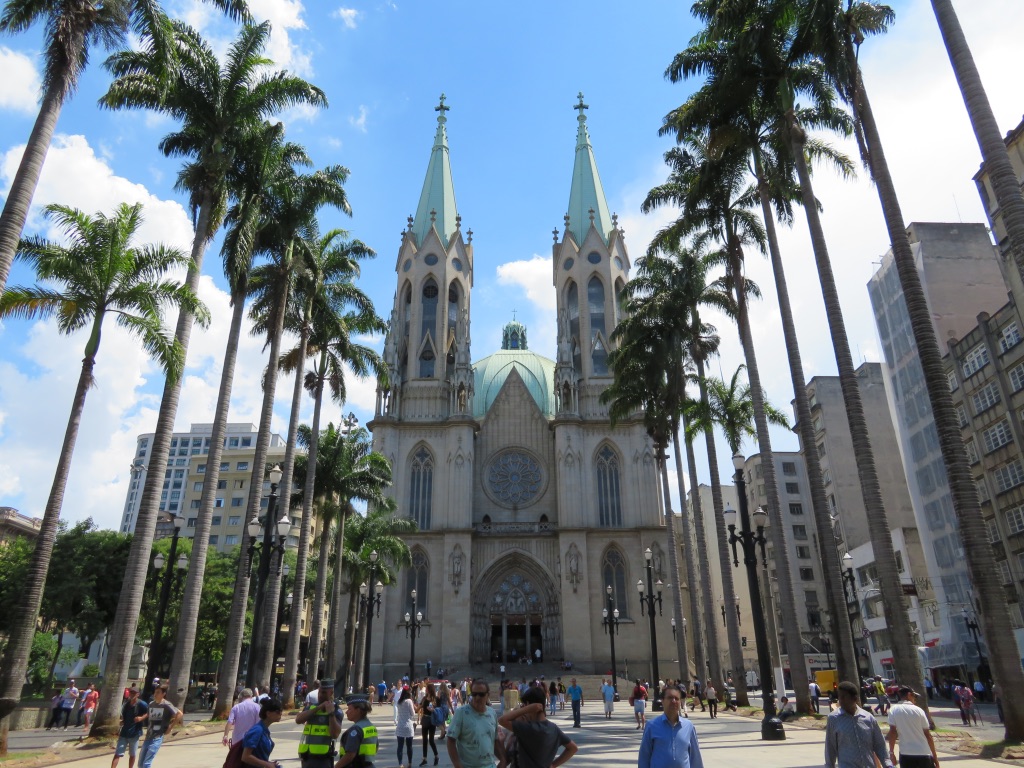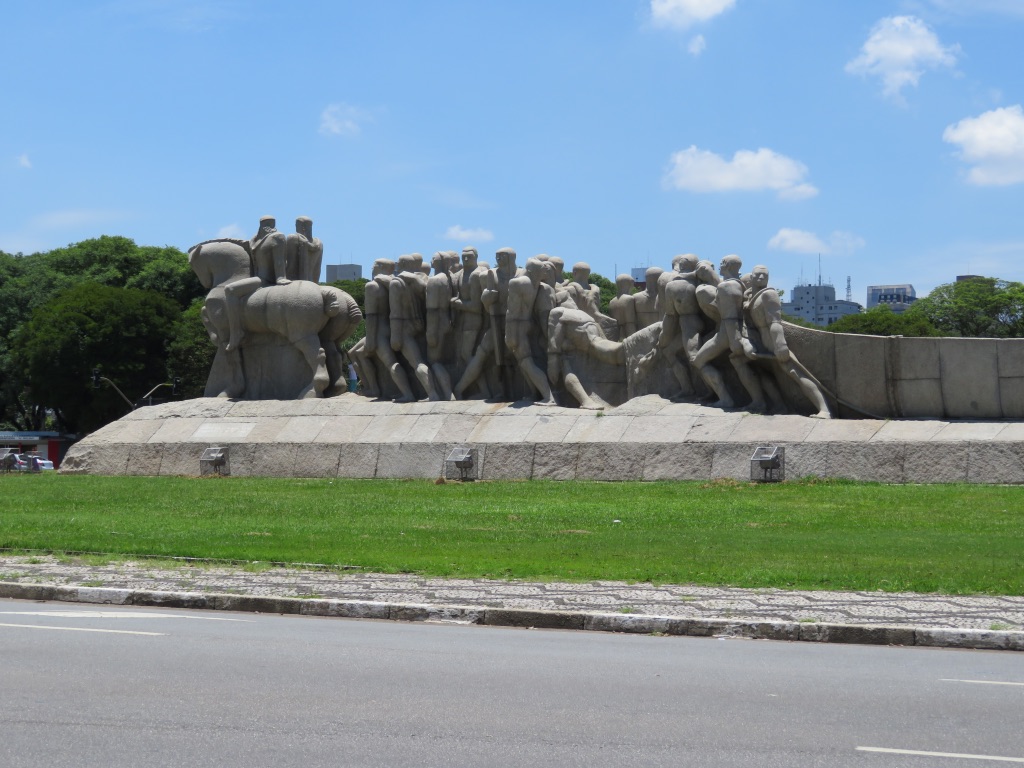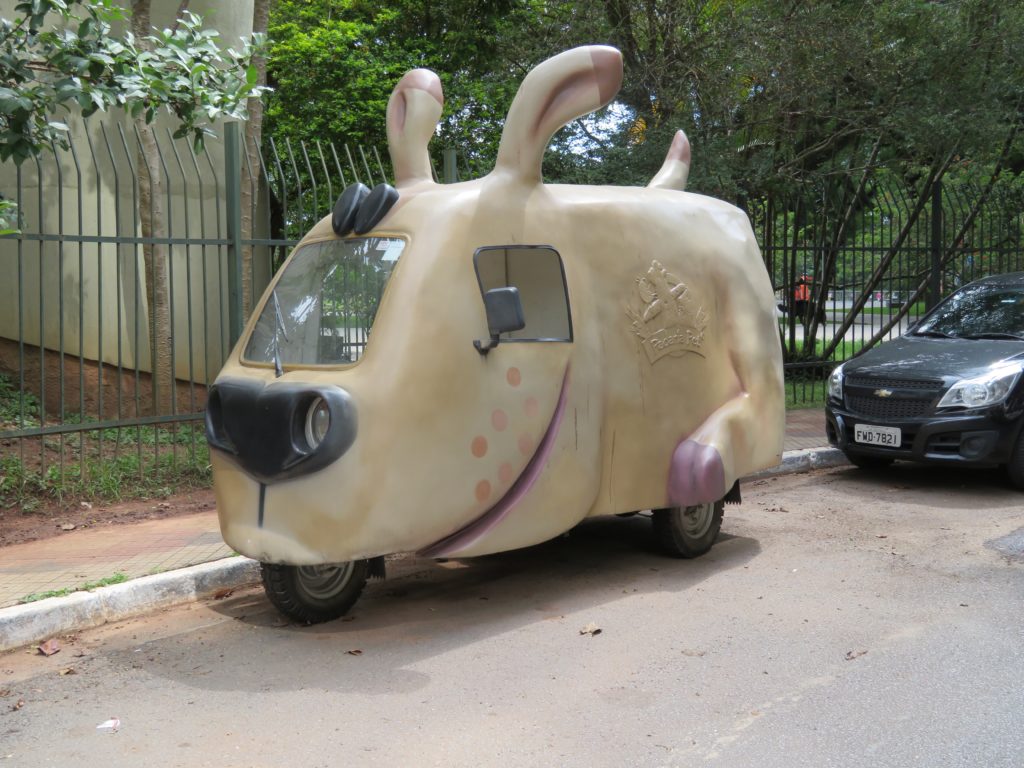Our first impression of São Paulo was its sheer vastness—truly one of the world’s megacities. Home to over 12 million people in the city proper and more than 22 million in the greater metropolitan area, it is the largest city in the Southern Hemisphere. Its scale is apparent from the start; our taxi ride from the airport to Paulista Avenue took 90 minutes to our IBIS Hotel on Paulista Avenue. São Paulo’s status as Brazil’s economic powerhouse was clear, with a sprawling metropolis built on innovation, industry, and relentless growth. A frequent comment we heard in São Paulo is that the Paulistanos work hard and provide economic backbone of Brazil whereas the Caricoas of Rio de Janeiro party hard but do not work.
Located at an altitude of 760 metres, São Paulo enjoys a subtropical climate, marked by warm, humid summers and mild winters. During our January visit, temperatures hovered around 35°C, and occasional tropical showers offered a refreshing break from the heat and humidity.
The contrast between modern São Paulo and its colonial past is striking. The sleek glass and steel towers of Paulista Avenue epitomise the city’s financial clout, while the decaying yet elegant architecture of the old colonial centre tells the story of its history. A particular standout is the São Paulo Cathedral (Catedral da Sé), a neo-Gothic masterpiece completed in 1954. Its immense dome, tall spires, and intricate stained glass windows are a testament to Brazil’s religious history, while also serving as a poignant reminder of the city’s early days.

Another glimpse into São Paulo’s past can be found at Casa das Rosas, an old mansion once home to one of the city’s coffee barons. Now a cultural centre, its rose garden was an oasis amidst the modern energy of Paulista Avenue, offering us a peaceful afternoon and our first beer on the beginning our year in South America thinking about the adventures to come and contemplating the energy, modernity and grandeur of this mega city.
Paulista Avenue and São Paulo’s Artistic Heart
On day two, we began exploring Paulista Avenue in earnest, heading straight to one of its most famous landmarks, the Museu de Arte de São Paulo (MASP). Founded in 1947, MASP is known for its distinctive Brutalist design, appearing to float above the ground, suspended by two bright red beams. Its transparent, glass-panelled exhibition format offers visitors a unique way to experience art: each piece is displayed in a way that you can walk around it, taking in both the artwork and its frame. This innovative display method feels symbolic of São Paulo itself—a city where, looking at things from a different angle can reveal new layers of complexity.
MASP’s collection is vast, ranging from European masters like Raphael, Rubens, and Picasso to modern Brazilian pieces. Among the highlights were works that depicted São Paulo during its early colonial period, capturing the evolving relationships between European settlers, indigenous peoples, and the landscape of a nascent Brazilian society. The museum also houses an impressive collection of Brazilian modernism, showcasing the unique blend of European, African, and indigenous influences that define the country’s artistic heritage.



Museu de Arte de São Paolo (MASP), São Paolo, Brazil
After MASP, we wandered through the Jardins District, one of the city’s wealthiest areas, characterised by leafy streets and luxury boutiques. Our destination was Ibirapuera Park, a sprawling green space that’s both a recreational hub and home to some of São Paulo’s most significant cultural monuments.
One of the park’s most striking features is Monumento às Bandeiras, a monumental sculpture by Victor Brecheret honouring the bandeirantes, the explorers who expanded Brazil’s territory in the 17th century. This immense stone sculpture captures the pioneering spirit that helped build São Paulo, though it also evokes the often violent expansion of colonial Brazil. Nearby, the Obelisk of São Paulo serves as a solemn reminder of the Constitutionalist Revolution of 1932, an event that shaped the city’s political history.

Ibirapuera Park also hosts the Afro-Brazil Museum, where we learned about the immense contributions of the African diaspora to Brazil’s history and culture. Although the exhibits felt slightly dated, the museum’s narrative is crucial for understanding Brazil’s social fabric, particularly the evolution of its diverse, multicultural identity.
Teatro Municipal and the Street Life of São Paulo
One of São Paulo’s grandest buildings is the Teatro Municipal, located in the heart of the city. Opened in 1911, this opulent theatre was inspired by Paris’ Palais Garnier and is a landmark of Brazilian cultural history. The grand façade, with its classical columns and lavish detailing, stands in stark contrast to the street life outside. Around the theatre, street vendors selling everything from homemade crafts to food bring an energetic, bustling atmosphere to the area. As we meandered through the street stalls, we couldn’t help but marvel at the mix of high culture inside the theatre and the vibrant street culture outside, a reflection of São Paulo’s many contradictions.


Teatro Municipal, São Paolo, Brazil
Liberdade: São Paulo’s Asian Soul
From the Teatro Municipal, we made our way to Liberdade, São Paulo’s Japanese district. The largest Japanese community outside of Japan resides here, but Liberdade’s Asian influences extend beyond Japan, encompassing Chinese and Korean culture as well. Walking through its streets, we were greeted by the sight of red torii gates, paper lanterns, and bustling markets selling everything from fresh sushi to imported goods. São Paulo’s status as a global city is nowhere more evident than here, where Asian traditions meld seamlessly into the Brazilian landscape. It’s a vibrant, colourful neighbourhood, offering a mix of Buddhist temples, Japanese restaurants, and eclectic shops, all reflecting the unique fusion of Asian and Brazilian cultures.
Liberdade is particularly popular on Sundays, when the street markets are in full swing. Stalls sell traditional Japanese street food such as takoyaki (octopus balls) and yakitori (grilled skewers), while artisans offer everything from hand-painted fans to kimonos. We spent a few hours exploring the market, savouring the rich scents and vivid colours, and soaking in the district’s lively energy.
Cemeteries, Graffiti, and the Bohemian Spirit of Vila Madalena
Another day, another contrasting neighbourhood. Our next stop was São Paulo’s Cemetery of Consolation, where towering family vaults and black marble mausoleums tell the story of São Paulo’s wealthy elite. Among the many grand tombs is the Cantarella Vault, home to Alfredo Oliani’s beautiful sculpture, The Last Goodbye, which powerfully captures themes of love and death. It’s one of the most poignant statues I’ve seen, a striking piece of art amidst the silence of the cemetery.


The Last Goodbye – Family Cantarella Vault, São Paulo Cemetery, São Paolo, Brazil
Just a short distance from this quiet space lies the vibrant neighbourhood of Vila Madalena, São Paulo’s bohemian heart. Known for its quirky shops, independent cafes, and, above all, its street art, Vila Madalena exudes creativity. The epicentre of this is Beco do Batman, a graffiti-covered alley where artists from around the world leave their mark. The street art here is constantly evolving, offering new works every time you visit. Some of the murals are abstract, while others are politically charged, making this area a living, breathing art gallery. We particularly loved a mural of a bull finally defeating the matador, and another of two girls framed by a ghostly handprint.





Vila Madalena isn’t just about the art—it’s also home to some of São Paulo’s best bars and cafes. We spent the rest of the enjoying a coffee and later some local craft beers in a couple of the many independent bars and cafes soaking up the lively, creative atmosphere.





A Traffic-Free Birthday Celebration
Our final day in São Paulo happened to coincide with the city’s birthday celebrations. Paulista Avenue was closed to traffic, transformed into a pedestrian haven filled with buskers, cyclists, and families enjoying the festivities. The musical diversity on display was impressive, though noticeably lacking in the bossa nova typically associated with Brazil. Instead, we were treated to rock, jazz, and even a Hendrix impersonator playing classic guitar riffs.
This traffic-free day offered us a more relaxed view of Paulista Avenue, contrasting sharply with its usual hustle and bustle. The Jardins District, with its gated properties perfectly groomed dogs and corporate business for the day being filled with many families and a much greater diversity of Paulistanos from all areas of the City. Highlighting that São Paulo is city of contrasts, where the wealthy stroll alongside skyscrapers; colonial history lives on in the shadows of modernity; where street art lives next to opulent theatres, and where different cultures, from Japanese to African to European, blend to form a vibrant urban tapestry.
Final Thoughts
São Paulo may not have the postcard-ready beaches of Rio de Janeiro, but its richness lies in its complexity. Whether it’s the arts, the parks, or the diverse neighbourhoods, São Paulo rewards those who are willing to explore beneath the surface. It’s a city that tells Brazil’s story in every street corner, every mural, and every towering skyscraper—a place that leaves you wanting more.

Dates: 22/01/2018 to 26/01/2018
